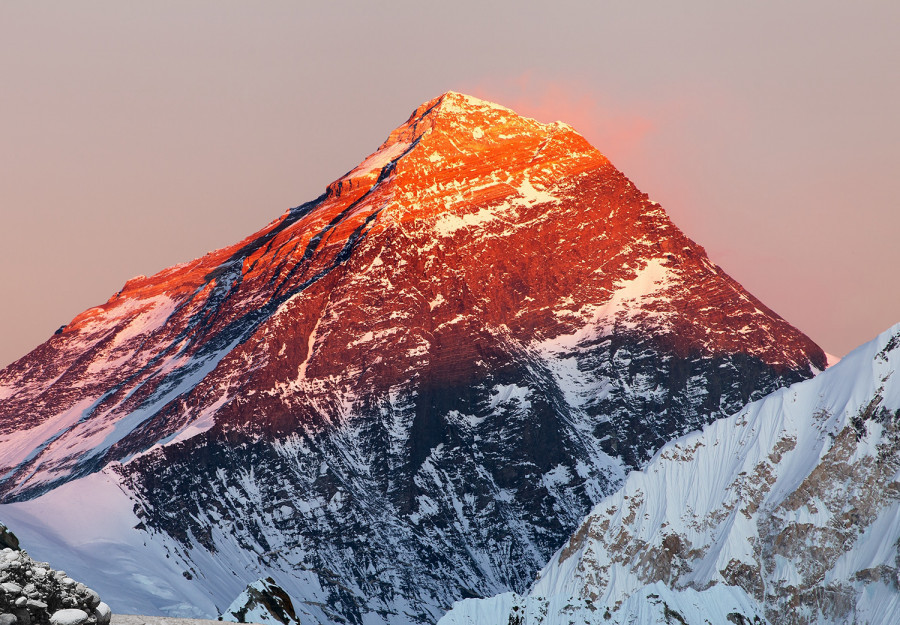
Last year, Pujan Gauchan, a local from Gharpajhong Rural Municipality-3 of Mustang district, replaced the roof of his mud-thatched house with corrugated metal sheets. He took the decision not out of choice but compulsion, as the mud used for roofing in the past has stopped shielding rain, especially during the fierce bouts of it.
Continuous and heavy rainfall has become a normal phenomenon in the past few years in the region, Gauchan said. “In the past, most houses used to be constructed from locally available materials—mud, stone, and logs. We even used mud as the roof,” he said. “But now this has all become a thing of the past.”
This has become a common refrain among residents in the Himalayan region, especially in Manang and Mustang, two of Nepal’s districts hit the worst by climate change.
Disasters fueled by extreme weather events—excessive rainfall in a short span of time, continuous rainfall for several days in the post-monsoon period, dry spells and drought—have become more pronounced and frequent.
Humde weather station of Manang recorded 232mm of pre-monsoon rain last year while the average in the past six years was 135mm. In other words, the pre-monsoon rainfall was 172 percent of normal.
People across the country were affected by the unseasonal rainfall in the first week of October. Several people died, scores were displaced, roads were obstructed and crops were destroyed as a result of the rainfall that continued for several days.
In Mustang, most mud-thatched houses leaked due to continuous rainfall occurring for several days.
“Many people in our areas have been bearing the brunt of climate change,” said Gauchan, who is also an architectural engineer. “Well-off people have started making concrete houses. But not everyone can afford them.”
Compared to other places in the country, concrete houses in districts like Mustang cost more, as transportation costs are too high.
Nepal is one of the world’s most vulnerable countries to the climate crisis and has witnessed extreme weather events in the past decade and a half.
Evidence indicates that the maximum temperature in Nepal is rising at a greater rate (0.05 degrees Celsius per year) than the minimum temperature (0.03 degrees Celsius per year).
Studies show rising global temperatures are likely to accelerate evaporation rates worldwide, leading to more rainfall. Moreover, as a result of a warming climate, the clouds start going up and even cross the mountains. It thus becomes possible that even places beyond the mountain see rainfall, says Madhukar Upadhya, a climate change expert.
“To cope with the effects of climate change, people have no option other than opting for concrete and metal structures, which are costly,” Upadhyay said. “Unlike mud-thatched houses, concrete houses do not provide warmth. Those using corrugated metal sheets will be affected much from the cold.”
Upadhyay said that he worked in Mustang some 40 years ago but had never seen rainfall in the area during the monsoon season. “Snowfall used to occur during winter and people used to clear the snow from the roof after the temperature started rising in summer,” he said.
For a long time, experts have been stressing the use of locally available materials as they are cost-effective and environment-friendly—and more beneficial. But the effects of climate change have left little choice to the locals.
“Concrete structures not only cost much, but also reduce energy efficiency,” said Suyesh Prajapati, team leader at Building Energy Efficiency Nepal, an European Union-funded project. “Authorities should work to find local alternatives that provide thermal comforts, instead of promoting concrete structures.”
Building Energy Efficiency Nepal has been working with local units to find locally available alternatives and also provide training to local unit officials, according to Prajapati.
Scores of studies and scientific analyses over the decade, and more recently, the IPCC report, have warned that Nepal is one of the most vulnerable countries to climate change and it cannot be business-as-usual to tackle the adverse impacts of the climate crisis.
Experts say climate variability is impacting the Nepali economy through lower agricultural productivity, road damage, and high energy imports during the dry season, among other impacts. Floods and landslides have been the most frequent hazards.
Southern and urban municipalities are more likely to experience flooding and heat stress, and northern regions are affected by increased erosion, landslides, water stress, and glacial lake overflow.
“It’s not only the people residing in mountainous areas who have been affected by the effects of climate change,” said Manjit Dhakal, a climate change expert. “Poor people from other parts of the country have also felt the heat.”
Back in Mustang, poor people have been forced to take loans to change roofs of houses to get protected from the heavy rainfall, according to Gauchan.
“We do not have any other alternatives left to deal with the effect of climate change, except opting for concrete structures,” Gauchan said.












